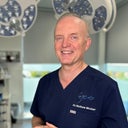In my opinion and experience, round breast implants should be sized by their diameter (which equals their height) and their forward dimension (profile) rather than by cc's of volume. What the surgeon needs to know is that the implant will fit properly behind the breast and what effect it will have in terms of that breast looking undistorted but bigger. The number of cc's is relative and not what you start with. In other words, for the same patient's breast you would look up the same diameter implant but decide on the different profile options based on whether a 1, 1 1/2, or 2 cup size increase is desired (assuming the patient has a reasonably average breast width for her chest circumference). In saline-filled implants, the profile choices of low, medium, and high are called Low, Medium, and High by Allergan but Mentor doesn't have a low profile saline-filled implant. It's Medium is the same as Allergan but it doesn't have a high profile implant that is scaled for the same width. It does have a Moderate Plus that is between the Medium and Allergan's High profile. In silicone gel-filled implants, the profile options of the two manufacturers are similar but they are called confusing things with the lowest profile called a moderate, the medium called a moderate plus, and only the high profile called a High. Allergan numbers these as Style 10, 15, and 20. In general, though, the lowest profile in saline-filled or silicone gel-filled results in about one cup size increase and this goes up roughly a half cup in size effect for the middle profile and the highest profile. The exception is in saline-filled round implants where the Mentor Moderate Plus is half way between the middle and highest profile. I haven't heard that this is changed in the last six months.

